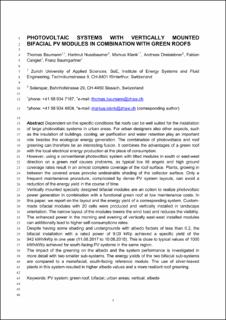Please use this identifier to cite or link to this item:
https://doi.org/10.21256/zhaw-18041Full metadata record
| DC Field | Value | Language |
|---|---|---|
| dc.contributor.author | Baumann, Thomas | - |
| dc.contributor.author | Nussbaumer, Hartmut | - |
| dc.contributor.author | Klenk, Markus | - |
| dc.contributor.author | Dreisiebner, Andreas | - |
| dc.contributor.author | Carigiet, Fabian | - |
| dc.contributor.author | Baumgartner, Franz | - |
| dc.date.accessioned | 2019-08-29T14:23:53Z | - |
| dc.date.available | 2019-08-29T14:23:53Z | - |
| dc.date.issued | 2019-09-15 | - |
| dc.identifier.issn | 0038-092X | de_CH |
| dc.identifier.issn | 1471-1257 | de_CH |
| dc.identifier.uri | https://digitalcollection.zhaw.ch/handle/11475/18041 | - |
| dc.description.abstract | Dependent on the specific conditions flat roofs can be well suited for the installation of large photovoltaic systems in urban areas. For urban designers also other aspects, such as the insulation of buildings, cooling, air purification and water retention play an important role besides the ecological energy generation. The combination of photovoltaics and roof greening can therefore be an interesting fusion. It combines the advantages of a green roof with the local electrical energy production at the place of consumption. However, using a conventional photovoltaic system with tilted modules in south or east-west direction on a green roof causes problems, as typical low tilt angels and high ground coverage rates result in an almost complete coverage of the roof surface. Plants, growing in between the covered areas provoke undesirable shading of the collector surface. Only a frequent maintenance procedure, complicated by dense PV system layouts, can avoid a reduction of the energy yield in the course of time. Vertically mounted specially designed bifacial modules are an option to realize photovoltaic power generation in combination with a functional green roof at low maintenance costs. In this paper, we report on the layout and the energy yield of a corresponding system. Custom-made bifacial modules with 20 cells were produced and vertically installed in landscape orientation. The narrow layout of the modules lowers the wind load and reduces the visibility. The enhanced power in the morning and evening of vertically east-west installed modules can additionally lead to higher self-consumptions rates. Despite having some shading and undergrounds with albedo factors of less than 0.2, the bifacial installation with a rated power of 9.09 kWp achieved a specific yield of the 942 kWh/kWp in one year (11.08.2017–10.08.2018). This is close to typical values of 1000 kWh/kWp achieved for south-facing PV systems in the same region. The impact of the greening on the albedo and the system performance is investigated in more detail with two smaller sub-systems. The energy yields of the two bifacial sub-systems are compared to a monofacial, south-facing reference module. The use of silver-leaved plants in this system resulted in higher albedo values and a more resilient roof greening. | de_CH |
| dc.language.iso | en | de_CH |
| dc.publisher | Elsevier | de_CH |
| dc.relation.ispartof | Solar Energy | de_CH |
| dc.rights | https://creativecommons.org/licenses/by-nc-nd/4.0/ | de_CH |
| dc.subject | PV system | de_CH |
| dc.subject | Albedo | de_CH |
| dc.subject | Green roof | de_CH |
| dc.subject | Bifacial | de_CH |
| dc.subject | Urban areas | de_CH |
| dc.subject | Vertical | de_CH |
| dc.subject.ddc | 621.3: Elektro-, Kommunikations-, Steuerungs- und Regelungstechnik | de_CH |
| dc.title | Photovoltaic systems with vertically mounted bifacial PV modules in combination with green roofs | de_CH |
| dc.type | Beitrag in wissenschaftlicher Zeitschrift | de_CH |
| dcterms.type | Text | de_CH |
| zhaw.departement | School of Engineering | de_CH |
| zhaw.organisationalunit | Institut für Energiesysteme und Fluid-Engineering (IEFE) | de_CH |
| dc.identifier.doi | 10.1016/j.solener.2019.08.014 | de_CH |
| dc.identifier.doi | 10.21256/zhaw-18041 | - |
| zhaw.funding.eu | No | de_CH |
| zhaw.originated.zhaw | Yes | de_CH |
| zhaw.pages.end | 146 | de_CH |
| zhaw.pages.start | 139 | de_CH |
| zhaw.publication.status | acceptedVersion | de_CH |
| zhaw.volume | 190 | de_CH |
| zhaw.embargo.end | 2021-09-15 | de_CH |
| zhaw.publication.review | Peer review (Publikation) | de_CH |
| zhaw.webfeed | Photovoltaik | de_CH |
| zhaw.author.additional | No | de_CH |
| Appears in collections: | Publikationen School of Engineering | |
Files in This Item:
| File | Description | Size | Format | |
|---|---|---|---|---|
| 2019_Klenk_Photovoltaic_systems_with_vertically_mounted_bifacial_PVmodues_SolarEnergy_ACCEPTED.pdf | Accepted Version | 1.27 MB | Adobe PDF |  View/Open |
Show simple item record
Baumann, T., Nussbaumer, H., Klenk, M., Dreisiebner, A., Carigiet, F., & Baumgartner, F. (2019). Photovoltaic systems with vertically mounted bifacial PV modules in combination with green roofs. Solar Energy, 190, 139–146. https://doi.org/10.1016/j.solener.2019.08.014
Baumann, T. et al. (2019) ‘Photovoltaic systems with vertically mounted bifacial PV modules in combination with green roofs’, Solar Energy, 190, pp. 139–146. Available at: https://doi.org/10.1016/j.solener.2019.08.014.
T. Baumann, H. Nussbaumer, M. Klenk, A. Dreisiebner, F. Carigiet, and F. Baumgartner, “Photovoltaic systems with vertically mounted bifacial PV modules in combination with green roofs,” Solar Energy, vol. 190, pp. 139–146, Sep. 2019, doi: 10.1016/j.solener.2019.08.014.
BAUMANN, Thomas, Hartmut NUSSBAUMER, Markus KLENK, Andreas DREISIEBNER, Fabian CARIGIET und Franz BAUMGARTNER, 2019. Photovoltaic systems with vertically mounted bifacial PV modules in combination with green roofs. Solar Energy. 15 September 2019. Bd. 190, S. 139–146. DOI 10.1016/j.solener.2019.08.014
Baumann, Thomas, Hartmut Nussbaumer, Markus Klenk, Andreas Dreisiebner, Fabian Carigiet, and Franz Baumgartner. 2019. “Photovoltaic Systems with Vertically Mounted Bifacial PV Modules in Combination with Green Roofs.” Solar Energy 190 (September): 139–46. https://doi.org/10.1016/j.solener.2019.08.014.
Baumann, Thomas, et al. “Photovoltaic Systems with Vertically Mounted Bifacial PV Modules in Combination with Green Roofs.” Solar Energy, vol. 190, Sept. 2019, pp. 139–46, https://doi.org/10.1016/j.solener.2019.08.014.
Items in DSpace are protected by copyright, with all rights reserved, unless otherwise indicated.